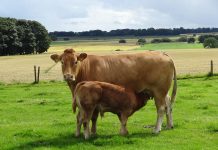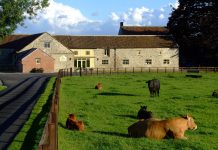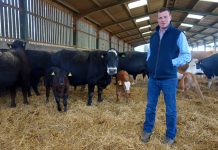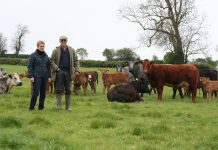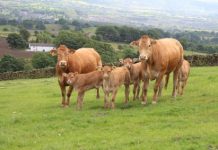Award-winning commercial beef producer, Phil Jones, manages to achieve the best of both worlds. While he runs his business with ruthless efficiency and a keen eye to profit, he also has a genuine love of cattle breeding and is just as enthusiastic as any pedigree breeder. Over the years, he has come to the conclusion that the Limousin fulfils all his requirements, largely because of its outstanding maternal characteristics and good conformation.
Phil was the deserving winner of the Farmers Weekly ‘Beef Farmer of the Year’ award in 2013, with the judges praising his clear focus on profit and excellent performance figures. They also commented favourably on his willingness to embrace new technology and his efforts to maintain high herd health status. One production figure which is bound to have swayed the panel is the post-weaning 1kg daily liveweight gain for the calves, which is achieved without using any concentrates.
Lan Farm is a part-rented, part-owned farm which covers 400 acres of land, situated at 650-800 feet above sea-level. The region has a fairly high rainfall average and the soil type ranges widely, including both peat and clay. It has been in organic production for well over a decade.
Phil mostly works alone on the family farm, although he is ably supported by his wife, Shan, and the couple’s two children, Manon, who is 13 years old and Gwion, aged 11. The children get very excited when they are awaiting the arrival of a new Limousin bull and they both enjoy helping out on the farm when they are not at school, comments Phil.
Anyone working with cattle on a daily basis gets a great deal of job satisfaction from admiring their visual appearance and Phil is no exception. He has a special affection for black Limousins and has recently registered a few of his own pedigree ‘Elfed’ females while the main herd is made up of just over 100 predominantly Welsh Black cows.
Historically, the farm retained two Charolais bulls until the purchase of Dyfri Upstart as a mature bull, specifically to breed replacement females. Phil was delighted with the growth, structure and length of the calves to the extent that he currently runs two Limousins and one Charolais.
All the cattle are sold as stores, with as many as 80-90% going to repeat private buyers. However Phil also likes to support the local organic sale at Carmarthen auction mart. Stores usually leave the farm in batches of 10-12 and weighing around 350kgs.
During the first few years of organic production, it was common to find conventional finishers outbidding organic producers, says Phil, but more recently the majority have been sold on to organic farms and are commanding a small premium over the market average.
Closed Herd
Three years ago, the discovery of a sub-fertile bull and a positive test result for BVD prompted Phil to re-think his cattle breeding policy. At the time, he relied on bought-in replacements, but the female side of the herd is now closed, with stock bulls quarantined on arrival.
EBVs
In the past, Phil placed little emphasis on EBVs, preferring instead to buy bulls purely on appearance. But his opinion changed radically after he attended a course on how to use EBVs to increase selection accuracy.
“The course was fantastic and it really opened my eyes to the potential of EBVs,” he says. “I think they are one heck of a tool, although they are not the only way to evaluate cattle. Rather than just seeing a bull at a sale, I like to visit the herd and look at his relations, wherever possible.”
Bull Selection
The number one quality that Phil requires of a bull is ease of calving, he stresses. Careful attention is also paid to daughter (maternal) calving ease, to produce replacement females that are able to calve without requiring assistance. Another policy implemented to minimise difficult calvings is the use of sexed semen on the heifers, so they produce smaller, female calves. Second in order of EBV priority are the sire’s 200 and 400-day growth rates. The use of heat detector collars, to identify cows bulling, has increased the choice of sires to include AI bulls and Phil spends a lot of time researching bulls using the Semenstore website and BASCO for EBVs.
Through his research and having a preference for a black cow, the first black Limousin bull was purchased at Brecon in May 2011 at a Breed Society sale. Tamarvalley Endymion came from Mr WB Harper at Way Farm, Holsworthy in Devon, with a price tag of 3,200gns and is sired by Edwards Valiant (by Edwards Sirloin) and out of Tamarvalley Virtuoso (by Mapleleaf Just So).
“I noticed the bull in the sale catalogue and went down to see him before the sale,” explains Phil. “In the three seasons we have had him, he has produced some very good calves and we are really pleased with his performance.”
“That visit to Mr Harper’s farm was when I fell for the black Limousins. There’s something a little bit different about them and they are very pleasing to look at. I believe that black Limousins are definitely the way forward for a commercial breeder.”
A second black Limousin stock bull arrived on the farm in 2013. Knock Hale and Hearty was bought privately from Mr A Howie’s herd at Peterhead in Aberdeenshire, with Phil making the 1,000-mile round trip to see the bull in his home environment before purchase.
“I did my research and I knew that it was a quality herd containing mostly black Limousins. It did not disappoint and I was pleased to see the cattle were not being pushed too hard. Hale and Hearty won’t be used until May, when he’ll go in with the heifers.”
One AI bull whose progeny are eagerly awaited is Newhouse Fullback. By Tamarvalley Boscastle, he was sold for 16,000gns at Stirling in 2012. Fullback has a maternal production value of 22, which puts him in the top 10% of the breed.
Cow Selection
Phil has firm ideas about the selection of females as replacements.
“The black Limousin has fantastic maternal characteristics; the females are extremely milky. This is a highly desirable trait; milk is free and feed is expensive, so why spend money when the cow can rear the calf without supplementation? Even a saving of £10/calf will add up, when you consider the figure across a whole herd.
“I like to breed a tidy-looking, square cow and let the bull put the shape on the calf. A mature cow should weigh around 600kgs at weaning; I don’t want anything too big.”
Block Calving
Calving used to take place over a prolonged period during spring and summer, but Phil decided that block calving would help to ease the workload. Calving now takes place in March, April and May.
“The only way to move to block calving is to cull females which don’t get in-calf over a set period and that is what I have done, although I still might give the benefit of the doubt to a young cow which has slipped.
“Block calving has a number of benefits; it means that I can focus on the calving period and not get too distracted by other jobs that need to be done on the farm. When it comes to calf castration or de-budding, I can bring the cattle in and go through all the youngstock at the same time. All the calves are weaned in the first week of the New Year, for simplicity’s sake.”
Herd Management
Hitting a 1kg/day liveweight gain average for weaned calves without the use of concentrates and on an organic system is something to be very proud of. Phil puts much of his success down to his home-grown “rocket fuel.” It is a combination of red clover silage, plus barley/pea whole crop silage.
I usually have about 20 acres of red clover and grass growing at any one time, with the mix sown over the peas or barley. In the early days, I used Italian ryegrasses, but they were too aggressive and swamped the clover. Perennial ryegrasses work much better. The secret is to avoid cutting or grazing the red clover below the crown; otherwise it won’t grow back.”
Weighing
Phil is a great fan of regular calf weighing and the task is carried out monthly from weaning onwards, with help from his daughter and son.
“The children particularly like helping me to weigh the calves. I feel it’s a very important element of cattle breeding; a milk producer gets information on how his cows are performing twice a day in the parlour. Beef production is no different and if the cattle aren’t being weighed, then I have no clear picture of how they are progressing. I also weigh the cows at weaning, to give me a better idea of how to feed them as they enter the dry stage.”
The ability to adapt to changing markets and keep control of costs is usually an indicator of business success and Phil already has his sights set on a second enterprise.
“I’m looking forward to reaching the stage where I will have surplus black Limousin females for breeding. That will give me a second enterprise. I’m just like every other farmer; I have bills which need to be paid. My philosophy is simple; cash is king and quality is queen!” he says.
Herd Health Plan
The herd is part of the SRUC (Scotland’s Rural College) Premium Cattle Health Scheme. As well as receiving a BVD vaccination, the calves are also protected against pneumonia at housing.
Cow Efficiency Project
Lan Farm has been an *HCC and Farming Connect Demonstration Farm and this has led to the farm becoming involved in a project to monitor cow efficiency. Using bulls with high growth EBVs will produce progeny that potentially have increased mature weight which will add to the maintenance cost of keeping the cow. By weighing the cows and calves at weaning and condition-scoring the cows, the change to Limousin genetics from Welsh Black is being evaluated.
The first year’s data showed that the younger cows appeared to be breeding a calf that has superior growth, maybe as a result of choosing good growth EBV bulls to breed the dam line, but also appear to be rearing it well. This better calf performance however was at the expense of cow body condition score and weight which has possible repercussions on the ability of these cows to rebreed to avoid a slippage in their calving pattern.
The challenge for the future will be to maintain a herd of medium-sized fertile animals capable of suiting Welsh upland farms, while continuing to push for higher growth rates in their calves. Phil is confident that the Limousin will help him deliver this objective.
*HCC (Hybu Cig Cymru/Meat Promotion Wales)
Phil Jones and his family will be hosting an RABDF Farm Walk on 29th July 2014










